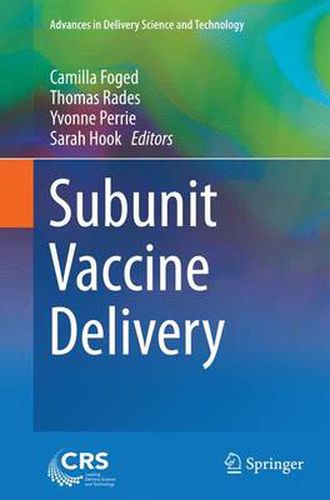Readings Newsletter
Become a Readings Member to make your shopping experience even easier.
Sign in or sign up for free!
You’re not far away from qualifying for FREE standard shipping within Australia
You’ve qualified for FREE standard shipping within Australia
The cart is loading…






This title is printed to order. This book may have been self-published. If so, we cannot guarantee the quality of the content. In the main most books will have gone through the editing process however some may not. We therefore suggest that you be aware of this before ordering this book. If in doubt check either the author or publisher’s details as we are unable to accept any returns unless they are faulty. Please contact us if you have any questions.
This comprehensive volume compiles the concepts essential for the understanding of the pharmaceutical science and technology associated with the delivery of subunit vaccines. Twenty-one chapters are divided into four main parts: (I) Background; (2) Delivery Systems for Subunit Vaccines; (3) Delivery Routes, Devices and Dosage Forms; and (4) Pharmaceutical Analysis and Quality Control of Vaccines. Part one provide a basic background with respect to immunology and general vaccine classification. In part two, it presents representative types of vaccine delivery systems individually with focus on the physicochemical properties of the systems and their significance for the immune response they stimulate. These delivery systems include aluminum adjuvants, emulsions, liposomes, bilosomes, cubosomes/hexosomes, ISCOMs, virus-like particles, polymeric nano- and microparticles, gels, implants and cell-based delivery systems.
Following these chapters, part three addresses the challenges associated with vaccine delivery via specific routes of administration-in particular subcutaneous, intramuscular, oral, nasal, pulmonary, transdermal and vaginal administration. Furthermore, the specific administration routes are discussed in combination with device technologies relevant for the respective routes as well as dosage forms appropriate for the device technology. Finally, the fourth part concerns pharmaceutical analysis and quality control of subunit vaccines.
$9.00 standard shipping within Australia
FREE standard shipping within Australia for orders over $100.00
Express & International shipping calculated at checkout
This title is printed to order. This book may have been self-published. If so, we cannot guarantee the quality of the content. In the main most books will have gone through the editing process however some may not. We therefore suggest that you be aware of this before ordering this book. If in doubt check either the author or publisher’s details as we are unable to accept any returns unless they are faulty. Please contact us if you have any questions.
This comprehensive volume compiles the concepts essential for the understanding of the pharmaceutical science and technology associated with the delivery of subunit vaccines. Twenty-one chapters are divided into four main parts: (I) Background; (2) Delivery Systems for Subunit Vaccines; (3) Delivery Routes, Devices and Dosage Forms; and (4) Pharmaceutical Analysis and Quality Control of Vaccines. Part one provide a basic background with respect to immunology and general vaccine classification. In part two, it presents representative types of vaccine delivery systems individually with focus on the physicochemical properties of the systems and their significance for the immune response they stimulate. These delivery systems include aluminum adjuvants, emulsions, liposomes, bilosomes, cubosomes/hexosomes, ISCOMs, virus-like particles, polymeric nano- and microparticles, gels, implants and cell-based delivery systems.
Following these chapters, part three addresses the challenges associated with vaccine delivery via specific routes of administration-in particular subcutaneous, intramuscular, oral, nasal, pulmonary, transdermal and vaginal administration. Furthermore, the specific administration routes are discussed in combination with device technologies relevant for the respective routes as well as dosage forms appropriate for the device technology. Finally, the fourth part concerns pharmaceutical analysis and quality control of subunit vaccines.